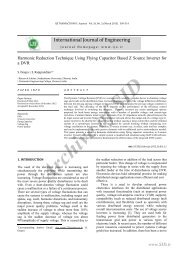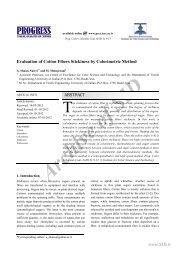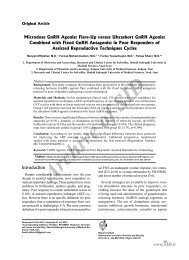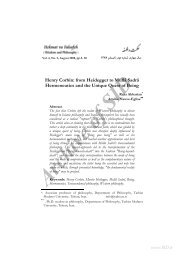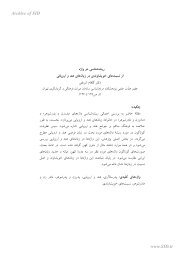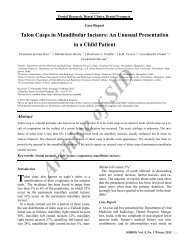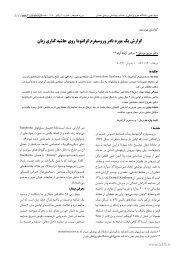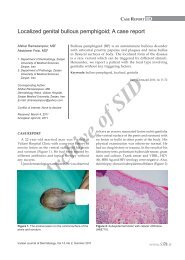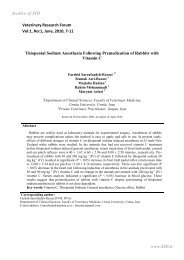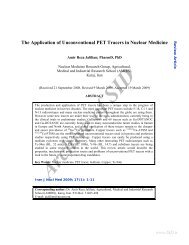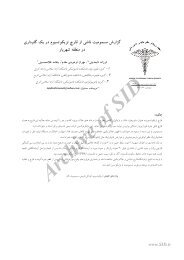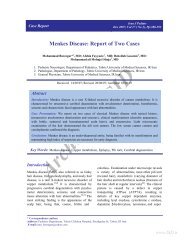Scape anatomy of Allium sect. Allium (Alliaceae) in Iran
Scape anatomy of Allium sect. Allium (Alliaceae) in Iran
Scape anatomy of Allium sect. Allium (Alliaceae) in Iran
Create successful ePaper yourself
Turn your PDF publications into a flip-book with our unique Google optimized e-Paper software.
JSUT 35 (1), 2009, p. 1-5<br />
<strong>Scape</strong> <strong>anatomy</strong> <strong>of</strong> <strong>Allium</strong> <strong>sect</strong>. <strong>Allium</strong> (<strong>Alliaceae</strong>) <strong>in</strong> <strong>Iran</strong><br />
Miryeganeh M., Movafeghi A.*<br />
Plant Biology Department, Faculty <strong>of</strong> Natural Sciences, University <strong>of</strong> Tabriz, Tabriz, <strong>Iran</strong>.<br />
* Correspond<strong>in</strong>g author, e-mail: amovafe@homail.com<br />
(received: 01/09/2008 ; accepted: 01/02/2009)<br />
Abstract<br />
The genus <strong>Allium</strong> encompasses over 750 species which have been classified <strong>in</strong>to 15 subgenera and 72 <strong>sect</strong>ions.<br />
Section <strong>Allium</strong> is one <strong>of</strong> the most economically important <strong>sect</strong>ions <strong>of</strong> the genus, conta<strong>in</strong><strong>in</strong>g several medic<strong>in</strong>al and<br />
edible species. The <strong>sect</strong>ion <strong>in</strong>cludes those species <strong>of</strong> <strong>Allium</strong> with a well developed bulb, stem (never basal) leaves and<br />
filaments <strong>in</strong> two dist<strong>in</strong>ct whorls, the outer nearly always simple and the <strong>in</strong>ner tricuspidate. The objectives <strong>of</strong> the<br />
current study were to compare the scape anatomical features <strong>of</strong> some species <strong>of</strong> the <strong>sect</strong>ion <strong>Allium</strong>. Some<br />
characteristics such as diameter <strong>of</strong> the cross <strong>sect</strong>ion, palisade parenchyma, spongy parenchyma, and vascular bundles<br />
as well as number <strong>of</strong> vascular bundles, and sclerenchymatous layers were studied. On the basis <strong>of</strong> the results obta<strong>in</strong>ed,<br />
although the species <strong>of</strong> <strong>Allium</strong> <strong>sect</strong>ion <strong>Allium</strong> form a relatively homogeneous group, some dist<strong>in</strong>ctions among cross<strong>sect</strong>ions<br />
<strong>of</strong> scapes are evident. In fact, our f<strong>in</strong>d<strong>in</strong>gs <strong>of</strong>fer a comprehensive survey us<strong>in</strong>g anatomical traits for<br />
delimitation and diagnos<strong>in</strong>g species <strong>of</strong> the <strong>sect</strong>ion <strong>Allium</strong> and provide a platform for further taxonomic <strong>in</strong>vestigations.<br />
Keywords: <strong>Allium</strong>; <strong>Alliaceae</strong>, <strong>Scape</strong> <strong>anatomy</strong>; Taxonomy, <strong>Iran</strong><br />
Introduction<br />
<strong>Allium</strong> L. (<strong>Alliaceae</strong>) is the largest genus <strong>of</strong> the<br />
petaloid monocots, encompass<strong>in</strong>g over 750 species<br />
(Friesen et al. 2006). This divers and taxonomically<br />
difficult genus is characterized by hav<strong>in</strong>g bulbs<br />
enclosed <strong>in</strong> membranous tonics, free or almost free<br />
tepals, and <strong>of</strong>ten a subgynobasic style. The largest<br />
numbers <strong>of</strong> species are found primarily throughout<br />
the temperate, semi-arid and arid regions <strong>of</strong> northern<br />
hemisphere (Fritsch & Friesen 2002). The ma<strong>in</strong><br />
centre <strong>of</strong> diversity <strong>of</strong> the genus is considered <strong>in</strong> the<br />
mounta<strong>in</strong>ous areas <strong>of</strong> southwest and central Asia<br />
<strong>in</strong>clud<strong>in</strong>g the territory <strong>of</strong> <strong>Iran</strong> (Fritsch & Friesen<br />
2002). Here the genus seems to be typical for the<br />
<strong>Iran</strong>o-Turanian phyto-geographical region and<br />
displays a high level <strong>of</strong> specific endemism (Mat<strong>in</strong><br />
Archive <strong>of</strong> SID<br />
1992). One <strong>of</strong> the most recent classifications<br />
proposes 15 subgenera and 72 <strong>sect</strong>ions for the genus<br />
<strong>Allium</strong> (Friesen et al. 2006). Accord<strong>in</strong>gly, the<br />
recognized <strong>Allium</strong> species <strong>in</strong> <strong>Iran</strong> fit <strong>in</strong> 7 subgenera<br />
and 29 <strong>sect</strong>ions.<br />
Section <strong>Allium</strong>, the subject <strong>of</strong> the present study,<br />
<strong>in</strong>cludes species <strong>of</strong> <strong>Allium</strong> with a well developed<br />
bulb, stem (never basal) leaves, campanulate to cupshaped<br />
(never stellate) flowers, and filaments <strong>in</strong> two<br />
dist<strong>in</strong>ct whorls, the outer three nearly always simple<br />
and the <strong>in</strong>ner three markedly tricuspidate (rarely 5-7<br />
cuspidate) with the anther attached to the median<br />
cuspid (Mathew 1996). The <strong>sect</strong>ion comprises about<br />
115 species worldwide; at least 30 <strong>of</strong> which<br />
<strong>in</strong>clud<strong>in</strong>g 6 endemics grow <strong>in</strong> <strong>Iran</strong> (Wendelbo<br />
1971). Based on the morphology, <strong>anatomy</strong>,<br />
karyology and molecular systematics <strong>of</strong> the species,<br />
<strong>sect</strong>ion <strong>Allium</strong> is a homogeneous, well-def<strong>in</strong>ed and<br />
probably monophyletic group and therefore is <strong>of</strong><br />
high taxonomic <strong>in</strong>terest (Mathew 1996; Fritsch &<br />
Astanova 1998; Fritsch ). Interest<strong>in</strong>gly, this <strong>sect</strong>ion<br />
<strong>in</strong>cludes a number <strong>of</strong> economically important<br />
species such as A. porrum (leek), A. sativum<br />
(garlic), A. ampeloprasum var. ampeloprasum<br />
(Russian garlic or elephant garlic) and A.<br />
ampeloprasum var. kurrat (kurrat, Egyptian leek).<br />
Most important anatomical studies on <strong>Allium</strong><br />
were focused on the structure <strong>of</strong> the bulb scales<br />
(Fritsch 1988) and the leaf structure (De Mason<br />
1990; Fahn 1967; Fritsch, 1988; 1993; Mathew,<br />
1996; Miceli et al., 1984; Saghir & Mann, 1969;<br />
Tanker & Kurucu, 1981; Traub, 1968). Intrigu<strong>in</strong>gly,<br />
<strong>anatomy</strong> <strong>of</strong> scape and its potential use <strong>in</strong> the<br />
systematics and delimitation <strong>of</strong> the species <strong>of</strong> <strong>Allium</strong><br />
received little attention (Friedlander 1988; Jacobsen<br />
1979; Fritsch 1992; Uysal 1999). The ma<strong>in</strong> scope <strong>of</strong><br />
the present study is to provide a comprehensive<br />
scape anatomical study <strong>in</strong> <strong>Allium</strong> <strong>sect</strong>. <strong>Allium</strong> <strong>in</strong><br />
<strong>Iran</strong>, to f<strong>in</strong>d useful characters <strong>in</strong> taxonomy <strong>of</strong> the<br />
species, and to contribute towards the taxonomic<br />
<strong>in</strong>formation available on the <strong>sect</strong>ion. Another long<br />
term goal is to exam<strong>in</strong>e the scape <strong>anatomy</strong> <strong>of</strong> some<br />
www.SID.ir
2 Miryeganeh & Movafeghi JSUT, 35 (1), 2009<br />
species <strong>of</strong> the <strong>sect</strong>ion <strong>in</strong> detail, as a basis for further<br />
anatomical studies <strong>of</strong> other members <strong>of</strong> the genus.<br />
Materials and methods<br />
<strong>Scape</strong> anatomical characters <strong>of</strong> 12 <strong>Allium</strong> species <strong>of</strong><br />
the <strong>sect</strong>ion <strong>Allium</strong> were studied by means <strong>of</strong> light<br />
microscope. Plant materials <strong>of</strong> some species were<br />
collected from their natural habitats and other<br />
samples (3 species) were taken from the herbarium<br />
material housed at Tehran University Herbarium<br />
(TUH). A list <strong>of</strong> voucher specimens <strong>of</strong> the species is<br />
presented <strong>in</strong> Table 1.<br />
The plant materials were fixed <strong>in</strong> 70% ethanol for<br />
3 days, and the cross-<strong>sect</strong>ions were prepared from<br />
the upper 1/3 <strong>of</strong> scape us<strong>in</strong>g commercial razor<br />
blades. The <strong>sect</strong>ions were sta<strong>in</strong>ed with safran<strong>in</strong> and<br />
fast green (Gerlach 1977) prior to be dehydrated<br />
through a graded ethanol series. Thereafter, they<br />
were cleared with xylene and mounted <strong>in</strong> Canada<br />
balsam. The <strong>sect</strong>ions were then studied us<strong>in</strong>g a<br />
Nikon E-1000 light microscope. A number <strong>of</strong><br />
characters such as shape and diameter <strong>of</strong> cross<strong>sect</strong>ions,<br />
number <strong>of</strong> rows <strong>of</strong> the vascular bundles,<br />
number <strong>of</strong> vascular bundles <strong>in</strong> each row, number <strong>of</strong><br />
rows <strong>of</strong> parenchyma and the diameter <strong>of</strong> vascular<br />
bundles were scored by exam<strong>in</strong><strong>in</strong>g <strong>of</strong> at least 5<br />
cross-<strong>sect</strong>ions.<br />
Results<br />
<strong>Scape</strong> anatomical features <strong>of</strong> species studied are<br />
summarized <strong>in</strong> Table 2. In cross-<strong>sect</strong>ions <strong>of</strong> scapes,<br />
which were mostly circular and rarely elliptic (i.e. <strong>in</strong><br />
A. qaradaghense) (Fig. 1 & 2), fundamental tissues<br />
such as epidermis, parenchyma, sclerenchyma, and<br />
vascular bundles were observed.<br />
Table 1. Collection data and voucher number <strong>of</strong> <strong>Allium</strong> specimens exam<strong>in</strong>ed here from scape anatomical po<strong>in</strong>t <strong>of</strong> view.<br />
The voucher specimens are located <strong>in</strong> TUH.<br />
Species<br />
A. aff<strong>in</strong>e Ledeb.<br />
A. atroviolaceum Boiss.<br />
A. borszczowii Regel<br />
A. dictyoscordum Vved.<br />
A. erubescens C. Koch<br />
A. iranicum (Wendelbo) Wendelbo<br />
A. laeve Wendelbo & Von Bothmer<br />
A. longicuspis Regel<br />
A. phanerantherum Boiss. &<br />
A. qaradaghense Fe<strong>in</strong>br.<br />
A. rotundum L.<br />
A. subv<strong>in</strong>eale Wendelbo<br />
Collection data<br />
E Azarbaijan, 50-60 km to Zanjan from Mianeh<br />
E Azarbaijan, SW Tabriz, E Azarbaijan, Basmenj road, Liqvan village<br />
????<br />
E Azarbaijan, Tabriz university<br />
W. Azarbaijan, between Naghadeh and Piranshahr<br />
E Azarbaijan, SW Tabriz, E Azarbaijan, Basmenj road, Liqvan village<br />
Lorestan, Khorramabad, Keshvar road, 5 km to Nuzhan pass<br />
E Azarbaijan, SW Tabriz, ????? E Azarbaijan, Basmenj road, Liqvan village<br />
E Azarbaijan, SW Tabriz,????<br />
E. Azarbaijan, 5 km N Tabriz, Dand mounta<strong>in</strong>s<br />
E Azarbaijan, Tabriz to Marand, ca. 15 km to Marand, SW Marand, Mishu-dagh mounta<strong>in</strong>s<br />
E Azarbaijan, Maraghe, Chenar (NW <strong>of</strong> Maraghe)<br />
Archive <strong>of</strong> SID<br />
Herbarium<br />
28027-TUH<br />
37047-TUH<br />
9908-TUH<br />
37036-TUH<br />
4197-TUH<br />
37035-TUH<br />
21829-TUH<br />
37037-TUH<br />
37046-TUH<br />
37051-TUH<br />
37040-TUH<br />
37042-TUH<br />
Table 2. Details <strong>of</strong> scape <strong>anatomy</strong> <strong>of</strong> <strong>Allium</strong> species exam<strong>in</strong>ed here. All sizes <strong>in</strong> columns 1, 2, 3, 4, and 12 represent the<br />
mean and are <strong>in</strong> µm. Column 1: Diameter <strong>of</strong> the <strong>sect</strong>ion, Column 2: Diameter <strong>of</strong> outer parenchymatous layer (palisade),<br />
Column 3: Diameter <strong>of</strong> <strong>in</strong>ner parenchymatous layers (spongy), Column 4: Diameter <strong>of</strong> outer layers <strong>of</strong> pith parenchyma,<br />
Column 5: Epidermis state (s<strong>in</strong>uate, smooth), Column 6:Number <strong>of</strong> vascular bundles, Column 7: Number <strong>of</strong> circles <strong>of</strong><br />
vascular bundles, Column 8: Number <strong>of</strong> vascular bundles <strong>in</strong> outer circle, Column 9: Number <strong>of</strong> vascular bundles <strong>in</strong><br />
median layer, Column 10: Number <strong>of</strong> vascular bundles <strong>in</strong> the <strong>in</strong>nermost circle, Column 11:Number <strong>of</strong> sclerenchymatous<br />
layers, Column 12: Diameter <strong>of</strong> Vascular bundles, Column 13: Mean <strong>of</strong> number <strong>of</strong> metaxylem <strong>in</strong> each bundles.<br />
Spieces 1<br />
A. aff<strong>in</strong>e Ledeb. 1714.2<br />
A. atroviolaceum Boiss 5603.5<br />
A. borszczowii Regel 2428.57<br />
A. dictyoscordum Vved 1500<br />
A. erubescens C. Koch 1142.85<br />
A. iranicum Wendelbo 3000<br />
A. laeve Wendelbo & Von Bothmer 1500<br />
A. longicuspis Regel 1500<br />
A. phanerantherum Boiss. & 4857.14<br />
A. qaradaghense Fe<strong>in</strong>ber 3175.67<br />
A. rotundum L 1625<br />
A. subv<strong>in</strong>eale Wendelbo 1875.14<br />
2<br />
64.86<br />
81.08<br />
54.05<br />
27.02<br />
81.08<br />
285.71<br />
81.08<br />
77.77<br />
135.13<br />
81.08<br />
55.55<br />
64.86<br />
3<br />
54.05<br />
54.05<br />
27.02<br />
27.02<br />
54.05<br />
108.10<br />
54.05<br />
66.66<br />
67.56<br />
162.16<br />
66.66<br />
54.05<br />
4<br />
81.08<br />
54.05<br />
135.13<br />
54.05<br />
121.62<br />
135.13<br />
40.54<br />
111.11<br />
135.13<br />
108.10<br />
133.33<br />
54.05<br />
5<br />
s<strong>in</strong>uate<br />
s<strong>in</strong>uate<br />
s<strong>in</strong>uate<br />
smooth<br />
smooth<br />
smooth<br />
s<strong>in</strong>uate<br />
s<strong>in</strong>uate<br />
s<strong>in</strong>uate<br />
s<strong>in</strong>uate<br />
s<strong>in</strong>uate<br />
s<strong>in</strong>uate<br />
6<br />
14<br />
27<br />
18<br />
13<br />
19<br />
26<br />
10<br />
22<br />
48<br />
48<br />
7<br />
18<br />
7<br />
2<br />
3<br />
2<br />
2<br />
2<br />
3<br />
1<br />
2<br />
3<br />
3<br />
1<br />
2<br />
8<br />
6<br />
11<br />
10<br />
5<br />
11<br />
10<br />
-<br />
14<br />
16<br />
26<br />
-<br />
11<br />
9<br />
-<br />
10<br />
-<br />
-<br />
-<br />
9<br />
-<br />
-<br />
20<br />
13<br />
-<br />
-<br />
10<br />
8<br />
6<br />
8<br />
8<br />
8<br />
7<br />
10<br />
8<br />
12<br />
9<br />
7<br />
7<br />
11<br />
5<br />
4<br />
6<br />
5<br />
3<br />
5<br />
3<br />
4<br />
3<br />
7<br />
5<br />
4<br />
12<br />
100<br />
114.28<br />
178.57<br />
128.57<br />
85.71<br />
180<br />
92.85<br />
121.62<br />
200<br />
108.10<br />
100<br />
114.28<br />
13<br />
9<br />
6<br />
5<br />
4<br />
8<br />
6<br />
8<br />
10<br />
6<br />
6<br />
10<br />
www.SID.ir
<strong>Scape</strong> <strong>anatomy</strong> <strong>of</strong> <strong>Allium</strong> <strong>sect</strong>. <strong>Allium</strong> (<strong>Alliaceae</strong>) <strong>in</strong> <strong>Iran</strong> 3<br />
Fig. 1: A typical cross-<strong>sect</strong>ion <strong>of</strong> scape <strong>in</strong>clud<strong>in</strong>g different<br />
fundamental tissues. C: cuticle, St: stomate, SSC: sub<br />
stomata cavity, OWE: outer wall <strong>of</strong> epidermis, E:<br />
epidermis, P: parenchyma, s: spongy cell, L: laticifere, Sc:<br />
sclerenchyma, OPP: outer layer <strong>of</strong> pith parenchyma, ph:<br />
phloem, MXy: metaxylem.<br />
Figure 2- General view <strong>of</strong> cross-<strong>sect</strong>ions <strong>of</strong> scape <strong>in</strong><br />
different species <strong>of</strong> <strong>Allium</strong> <strong>sect</strong>. <strong>Allium</strong> <strong>in</strong>clud<strong>in</strong>g: a) A.<br />
subv<strong>in</strong>eale, b) A. iranicum, c) A. qaradaghense, , d) A.<br />
dictyoscordum, e) A. phanerantherum f) A. atroviolaceum,<br />
g) A. longicuspis, h) A. dictyoscordum, i) A.<br />
phanerantherum, j) A. rotundum k) A. atroviolaceum, l) A.<br />
borszczowii.<br />
Archive <strong>of</strong> SID<br />
Epidermis: In all species <strong>in</strong>vestigated the scape<br />
epidermis was consisted <strong>of</strong> a s<strong>in</strong>gle cell layer. The<br />
cells were compact, radially elongated, and covered<br />
by a thick cuticle layer at outer surface (Fig. 1).<br />
Noticeably, the outer epidermal wall was much<br />
thicker than the <strong>in</strong>ner wall (Fig. 1, 3g-i). The type <strong>of</strong><br />
stomata with dist<strong>in</strong>ctive guard cells was recognized<br />
as xerophytic <strong>in</strong> all species studied (Fig. 2g, 2j, 3i).<br />
Parenchyma: Underly<strong>in</strong>g the s<strong>in</strong>gle-layered<br />
epidermis were few layers <strong>of</strong> chlorenchyma<br />
conta<strong>in</strong><strong>in</strong>g one to two row(s) <strong>of</strong> extremely curved<br />
palisade cells and 2-3 layers <strong>of</strong> isodiametric spongy<br />
cells (Fig. 1). In most specimens some secretory<br />
ducts were distributed throughout spongy<br />
parenchyma <strong>in</strong> dist<strong>in</strong>ctive arrangement and<br />
distribution patterns (Fig. 1). Obviously, one circle<br />
<strong>of</strong> dist<strong>in</strong>ct vascular bundles was located throughout<br />
the <strong>in</strong>ner parts <strong>of</strong> parenchyma just before<br />
sclerenchyma (Fig. 1, 2).<br />
Sclerenchyma: Sclerenchyma conta<strong>in</strong>ed three (A.<br />
erubescens, A. laeve and A. phanerantherum: Fig. 2e),<br />
four (A. atroviolaceum: Fig. 2f, A. longicuspis<br />
and A. subv<strong>in</strong>eale: Fig. 2a), five (A. aff<strong>in</strong>e, A.<br />
dictyoscordum: Fig. 2d and A. rotundum: Fig. 2j) or<br />
rarely six (A. borszczowii: Fig. 2l) and seven (A.<br />
qaradaghense: Fig. 2c) layers <strong>of</strong> cells. In all species,<br />
the sclerenchyma formed a closed circle under<br />
spongy cells (Fig. 1, 2). Centripetally, wall<br />
thickness and lignification-grade <strong>of</strong><br />
sclerenchymatous cells were decreased but their<br />
diameter was notably <strong>in</strong>creased.<br />
Fig. 3: Enlarged view <strong>of</strong> cross-<strong>sect</strong>ions <strong>of</strong> scape <strong>in</strong><br />
different species <strong>of</strong> <strong>Allium</strong> <strong>sect</strong>. <strong>Allium</strong> highlight<strong>in</strong>g<br />
vascular systems (a-f) and epidermis plus thick cuticle<br />
(g-i). a) <strong>Allium</strong> iranicum, b) A. qaradaghense, c) A.<br />
iranicum d) A. erubescens , e) A. atroviolaceum, f) A.<br />
borszczowii, g) A. rotundum, h) A. subv<strong>in</strong>eale.<br />
Vascular bundles: The scapes <strong>of</strong> all species<br />
possessed collateral vascular bundles with adaxial<br />
xylem (Fig. 1, 3a-f). One circle <strong>of</strong> somewhat large<br />
vascular bundle at distance <strong>of</strong> three to four cellular<br />
layers from sclerenchyma was located <strong>in</strong> central<br />
parenchyma (Fig. 2). The bundles were collateral <strong>in</strong><br />
all species and the phloem and the xylem were <strong>in</strong><br />
contact with each other directly. The central pith<br />
parenchyma with relatively large cells and large<br />
<strong>in</strong>tercellular spaces were observed only <strong>in</strong> early<br />
www.SID.ir
4 Miryeganeh & Movafeghi JSUT, 35 (1), 2009<br />
stages <strong>of</strong> development (Fig. 2b, e, 3f). About 30<br />
percent (<strong>in</strong> the mature state until 80 percent) <strong>of</strong> the<br />
transverse <strong>sect</strong>ions was devastated by maturation <strong>of</strong><br />
scapes (Fig 2). There were also <strong>in</strong>ternal vascular<br />
bundles <strong>in</strong> the pith region (Fig. 2b, e, f). Number,<br />
size and location <strong>of</strong> the bundles might be different<br />
<strong>in</strong> species <strong>of</strong> the genus whereas thick scapes (Fig.<br />
2e, f) usually have more vascular bundles than th<strong>in</strong><br />
ones (Fig. 2a). Generally, the <strong>in</strong>ner vascular bundles<br />
were larger than the outer ones and they owned<br />
more cells <strong>of</strong> phloem and xylem (Fig. 2e, f). In<br />
cross-<strong>sect</strong>ions, vascular bundles usually were<br />
surrounded by vascular sheaths consist<strong>in</strong>g <strong>of</strong> some<br />
layers <strong>of</strong> small parenchyma cells that were gradually<br />
converted to collenchyma or scleranchyma (Fig. 3af).<br />
Although <strong>in</strong>ner vascular bundles were arranged<br />
<strong>in</strong> zigzag or circular patterns, <strong>in</strong>ternal vascular<br />
bundles were almost <strong>in</strong> the all parts <strong>of</strong> central<br />
parenchyma.<br />
Discussion<br />
The species <strong>of</strong> <strong>Allium</strong> <strong>sect</strong>ion <strong>Allium</strong> form a<br />
relatively homogeneous and well characterized<br />
group regard<strong>in</strong>g taxonomical and molecular<br />
systematical studies (Mathew, 1996; Friesen et al.<br />
2006). Previous <strong>in</strong>vestigations revealed that<br />
anatomical <strong>in</strong>vestigations <strong>of</strong>fer valuable features for<br />
characteriz<strong>in</strong>g natural groups or dist<strong>in</strong>guish<strong>in</strong>g<br />
species from each other with<strong>in</strong> <strong>sect</strong>ions (Fritsch<br />
1988, Uysal 1999). Accord<strong>in</strong>gly, the current study<br />
provides a comprehensive survey for probable<br />
application <strong>of</strong> anatomical f<strong>in</strong>d<strong>in</strong>gs <strong>in</strong> delimitation<br />
and diagnos<strong>in</strong>g species <strong>of</strong> the <strong>sect</strong>ion <strong>Allium</strong>.<br />
The shape <strong>of</strong> the cross-<strong>sect</strong>ions was circular <strong>in</strong><br />
most species studied. The only exception was<br />
observed for A. qaradaghense with elliptic-oblong<br />
<strong>sect</strong>ions. However, this unusual shape might be<br />
Archive <strong>of</strong> SID<br />
caused by prepar<strong>in</strong>g mistreatments and represents<br />
probably an artifact. The marg<strong>in</strong> <strong>of</strong> the scape <strong>in</strong><br />
cross-<strong>sect</strong>ions provides another diagnostic character.<br />
The form <strong>of</strong> the scape epidermis <strong>of</strong> n<strong>in</strong>e species<br />
<strong>in</strong>clud<strong>in</strong>g A. aff<strong>in</strong>e, A. atroviolaceum, A.<br />
borszczowii, A. leave, A. longicuspis, A.<br />
phanerantherum, A. qaradaghense, A. rotundum<br />
and A. subv<strong>in</strong>eale’s was s<strong>in</strong>uate, whereas it was<br />
smooth <strong>in</strong> A. dictyoscordum , A. erubescens, and A.<br />
iranicum. Study <strong>of</strong> several <strong>sect</strong>ions confirmed that<br />
this form is <strong>in</strong>variable with<strong>in</strong> a given species and,<br />
therefore, is useful criteria for group<strong>in</strong>g the species.<br />
In all species palisade and spongy parenchyma <strong>in</strong><br />
the scape were totally differentiated. In fact, the<br />
<strong>in</strong>ner tissues <strong>of</strong> scapes were completely surrounded<br />
by two or three palisade parenchyma layers. The<br />
xerophytic stomata co<strong>in</strong>cide with the distributional<br />
characteristics <strong>of</strong> <strong>Allium</strong> species. Notably, all<br />
species owned laticifer tubes <strong>in</strong> scape mesophyle<br />
that have been previously found <strong>in</strong> leaves, bulb<br />
scales as well as <strong>in</strong> scape <strong>of</strong> <strong>Allium</strong> taxa (Fahn 1967;<br />
Huang & Sterl<strong>in</strong>g 1970; Yentür 1984). Three<br />
different patterns <strong>of</strong> laticifer distribution were<br />
dist<strong>in</strong>guished: a) at <strong>in</strong>ner boundary <strong>of</strong> palisade tissue<br />
(between palisade and spongy cells) (<strong>in</strong> A.<br />
qaradaghense, A. iranicum and A.<br />
phanerantherum), b) at <strong>in</strong>ner boundary <strong>of</strong><br />
isodiametric spongy cells (between parenchyma and<br />
sclerenchyma) (<strong>in</strong> A. laeve, A. subv<strong>in</strong>eale, A.<br />
borszczowii and A. rotundum), and c) throughout the<br />
spongy cells such as <strong>in</strong> A. atroviolaceum, A.<br />
erubescens and A. longicuspis. Because the places<br />
<strong>of</strong> laticifers are <strong>in</strong>consistent among different<br />
species, it seems to be an important anatomical<br />
character for taxonomic studies.<br />
So far, the <strong>anatomy</strong> <strong>of</strong> vegetative organs and<br />
scapes <strong>of</strong> <strong>Allium</strong> have been used for taxonomical<br />
purposes <strong>in</strong> different hierarchical levels. However,<br />
our work provides the first detailed anatomical<br />
f<strong>in</strong>d<strong>in</strong>gs on the species <strong>of</strong> the <strong>sect</strong>ion <strong>Allium</strong> and<br />
represents some dist<strong>in</strong>ctions among cross-<strong>sect</strong>ions<br />
<strong>of</strong> scapes. Hence, these results can be used <strong>in</strong><br />
addition to the data obta<strong>in</strong>ed from other anatomical<br />
studies <strong>of</strong> <strong>Allium</strong> species (Saghir & Mann 1969;<br />
Fritsch 1988; Mathew 1996). Besides, the<br />
anatomical survey <strong>of</strong> <strong>sect</strong>ion <strong>Allium</strong> <strong>of</strong>fer new tools<br />
for delimitation and diagnos<strong>in</strong>g <strong>of</strong> the species and<br />
provide a prospective for further taxonomic analysis<br />
<strong>of</strong> the genus.<br />
Acknowledgment<br />
The authors are thankful to Dr Sh. Zarre, Y. Salmaki<br />
and H. Moazzeni for critical read<strong>in</strong>g <strong>of</strong> manuscript.<br />
The f<strong>in</strong>ancial support <strong>of</strong> the Research Affairs <strong>of</strong> the<br />
University <strong>of</strong> Tabriz is acknowledged.<br />
References<br />
Brullo S., Pavone P., Salmeri C. 1997: <strong>Allium</strong> opor<strong>in</strong>anthum (<strong>Alliaceae</strong>), a new species from the NW<br />
Mediterranean area. Anales Jard. Bot. Madrid 55: 297-302.<br />
www.SID.ir
<strong>Scape</strong> <strong>anatomy</strong> <strong>of</strong> <strong>Allium</strong> <strong>sect</strong>. <strong>Allium</strong> (<strong>Alliaceae</strong>) <strong>in</strong> <strong>Iran</strong> 5<br />
De Mason D.A. 1990: Morphology and <strong>anatomy</strong> <strong>of</strong> <strong>Allium</strong>. In: Rab<strong>in</strong>owitch HD, Brewster JL (eds) Onions<br />
and allied crops vol. 1. CRC Press, Boca Raton, Fl<br />
Fahn A. 1967: Plant <strong>anatomy</strong>. Pergamon Press Ltd, Oxford.<br />
Fritsch R. 1988: Zur Wurzelanatmie <strong>in</strong> der Gattung <strong>Allium</strong> L. (<strong>Alliaceae</strong>). Beitr. Biol. Pfl. 67:129-160.<br />
Fritsch R. 1992: Anatomische Untersuchungen an der Blattspreite bei <strong>Allium</strong> L. (<strong>Alliaceae</strong>). I. Arten mit<br />
e<strong>in</strong>er e<strong>in</strong>fachen Leitbündelreihe. Flora 181: 83-100.<br />
Fritsch R. 1992: Über den Verlauf der Leitbündel <strong>in</strong> die Blattspreite bei der Gattung <strong>Allium</strong> L. Flora 186:<br />
237-249.<br />
Fritsch R. 1993: Anatomische Merkmale des Blütenschaftes <strong>in</strong> der Gattung <strong>Allium</strong> L. und ihre systematische<br />
Bedeutung. Bot. Jahrb. 115: 97-131.<br />
Fritsch R.M., Astanova S.B. 1998: Uniform karyotypes <strong>in</strong> different <strong>sect</strong>ions <strong>of</strong> <strong>Allium</strong> L. Fed. Rep. 109:<br />
539-549.<br />
Fritsch RM., Friesen N. 2002: Evolution, domestication and taxonomy. In: Rab<strong>in</strong>owitch HD, Currah L. (eds)<br />
<strong>Allium</strong> crop science: Recent advances. CABI Publ, Wall<strong>in</strong>gford, pp 5–30<br />
Friesen N., Fritsch R.M., Blattner. F.R. 2006: Phylogeny and new <strong>in</strong>trageneric classification <strong>of</strong> <strong>Allium</strong> L.<br />
(<strong>Alliaceae</strong>) based on nuclear rDNA ITS sequences. Aliso 22:372-395.<br />
Gerlach D. 1977: Botanische Mikrotechnik. Thieme Verlag, Stuttgart.<br />
Huang S.M., Sterl<strong>in</strong>g C. 1970: Laticifers <strong>in</strong> the bulb scales <strong>of</strong> <strong>Allium</strong>. Amer. J. Bot. 57:1000-1003.<br />
Kothari I.L. 1979. Morphohistogenic and anatomical studies <strong>in</strong> garlic: phloem. Proc. Indian Acad. Sci., B,<br />
88: 219-224.<br />
Mann L.K. 1952: Anatomy <strong>of</strong> garlic bulb and factors affect<strong>in</strong>g bulb development. Hilgardia 21: 195-251.<br />
Mat<strong>in</strong>, F. 1992: The genus <strong>Allium</strong> <strong>in</strong> <strong>Iran</strong>, diversity, distribution and endemism. In: Hanelt, P.,<br />
Hammer K. and Knüpffer, H. (eds.): The genus <strong>Allium</strong> - taxonomic problems and genetic resources. (Proc.<br />
Int. Symp. Gatersleben, June 11-13, 1991). IPK, Gatersleben: 193-194.<br />
Jacobsen TD. 1979: Numbers and Distributions <strong>of</strong> Vascular Bundles <strong>in</strong> <strong>Scape</strong>s <strong>of</strong> 3 Alliances <strong>of</strong> the Genus<br />
<strong>Allium</strong> Liliaceae. Amer. J. Bot 66: 991-2.<br />
Mathew B. 1996: A review <strong>of</strong> <strong>Allium</strong> Sect. <strong>Allium</strong>. Royal Botanic Gardens Kew.<br />
Mes, T.H.M., Friesen, N., Fritsch, R.M., Klaas, M., Bachmann, K. 1997: Criteria for sampl<strong>in</strong>g <strong>in</strong> <strong>Allium</strong><br />
based on chloroplast DNA PCR-RFLP'S. Systematic Botany 22: 701-712<br />
Miceli P., Fic<strong>in</strong>i G., Garbari, F. 1984: The genus <strong>Allium</strong> L. <strong>in</strong> Italy XIII. Morphological, caryological and<br />
leaf anatomical study <strong>in</strong> some C-W Mediterranean triploid populations <strong>of</strong> “<strong>Allium</strong> trifoliatum”. Cyr.<br />
Webbia 38: 793-803.<br />
Rudall P.J., Bateman R.M., Fay M.F., Eastman A. 2002: Floral <strong>anatomy</strong> and systematics <strong>of</strong> <strong>Alliaceae</strong> with<br />
particular reference to Gilliesia, apresumed <strong>in</strong><strong>sect</strong> mimic with strongly zygomorphic flowers. Amer. J.<br />
Bot. 89: 1867-1883.<br />
Saghir B.A., Mann L.K. 1969: Volatile constituents and leaf <strong>anatomy</strong> <strong>in</strong> relation to the basic chromosome<br />
دumbers <strong>in</strong> <strong>Allium</strong>. Tr. J. <strong>of</strong> Botany. 23: 137-148.<br />
Archive <strong>of</strong> SID<br />
Shah J.J., Kothari I.L. 1973: Histogenesis <strong>of</strong> garlic clove. Phytomorphology 23: 162-170.<br />
Tanker N., Kurucu S. 1981: Leaf <strong>anatomy</strong> <strong>in</strong> relation to taxonomy <strong>in</strong> species <strong>of</strong> <strong>Allium</strong> found <strong>in</strong> Turkey. Q.<br />
Jl. Crude Drug Res. 19: 173-179.<br />
Traub H.P. 1968: The subgenera, <strong>sect</strong>ions and sub<strong>sect</strong>ion <strong>of</strong> <strong>Allium</strong> L. Plant Life 24, pp. 147–163<br />
Uysal I. 1999: Morphological, anatomical and ecological studies on the two Turkish endemic species<br />
collected from Kaz Dagý (B1 Balýkesir) “<strong>Allium</strong> sibthorpianum Schultes & Schultes fil. and <strong>Allium</strong><br />
reuterianum Boiss.” Tr. J. Bot. 23: 137–148.<br />
Wendelbo P. 1971: <strong>Alliaceae</strong>. In: K. H. Rech<strong>in</strong>ger (ed.), Flora <strong>Iran</strong>ica. No. 76. Graz.<br />
Yentür S. 1984: Bitki Anatomisi Ist. Üniv. Fen Fak.Yay. 191, 248, Istanbul.<br />
www.SID.ir



